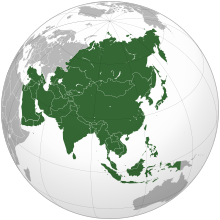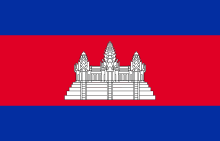Portal:Asia

 Asia (/ˈeɪʒə/ AY-zhə, UK also /ˈeɪʃə/ AY-shə) is the largest continent in the world by both land area and population. It covers an area of more than 44 million square kilometers, about 30% of Earth's total land area and 8% of Earth's total surface area. The continent, which has long been home to the majority of the human population, was the site of many of the first civilizations. Its 4.7 billion people constitute roughly 60% of the world's population. Asia shares the landmass of Eurasia with Europe, and of Afro-Eurasia with both Europe and Africa. In general terms, it is bounded on the east by the Pacific Ocean, on the south by the Indian Ocean, and on the north by the Arctic Ocean. The border of Asia with Europe is a historical and cultural construct, as there is no clear physical and geographical separation between them. It is somewhat arbitrary and has moved since its first conception in classical antiquity. The division of Eurasia into two continents reflects East–West cultural, linguistic, and ethnic differences, some of which vary on a spectrum rather than with a sharp dividing line. A commonly accepted division places Asia to the east of the Suez Canal separating it from Africa; and to the east of the Turkish Straits, the Ural Mountains and Ural River, and to the south of the Caucasus Mountains and the Caspian and Black seas, separating it from Europe. China and India traded places as the largest economies in the world from 1 to 1800 CE. China was a major economic power for much of recorded history, with the highest GDP per capita until 1500. The Silk Road became the main east–west trading route in the Asian hinterlands while the Straits of Malacca stood as a major sea route. Asia has exhibited economic dynamism as well as robust population growth during the 20th century, but overall population growth has since fallen. Asia was the birthplace of most of the world's mainstream religions including Hinduism, Zoroastrianism, Judaism, Jainism, Buddhism, Confucianism, Taoism, Christianity, Islam, Sikhism, as well as many other religions. (Full article...) Featured article The climate of India consists of a wide range of weather conditions across a vast geographic scale and varied topography. Based on the Köppen system, India hosts six major climatic sub types, ranging from arid deserts in the west, alpine tundra and glaciers in the north, and humid tropical regions supporting rain forests in the southwest and the island territories. Many regions have starkly different microclimates, making it one of the most climatically diverse countries in the world. The country's meteorological department follows the international standard of four seasons with some local adjustments: winter (December to February), summer (March to May), monsoon or rainy season (June to September), and a post-monsoon period (October and November). India's geography and geology are climatically pivotal: the Thar Desert in the northwest and the Himalayas in the north work in tandem to create a culturally and economically important monsoonal regime. As Earth's highest and most massive mountain range, the Himalayas bar the influx of frigid katabatic winds from the icy Tibetan Plateau and northerly Central Asia. Most of North India is thus kept warm or is only mildly chilly or cold during winter; the same thermal dam keeps most regions in India hot in summer. The climate in South India is generally warmer, and more humid due to its coastlines. However some hill stations in South India such as Ooty are well known for their cold climate. (Full article...)Selected Country Cambodia, officially the Kingdom of Cambodia, is a country in Southeast Asia on the Indochinese Peninsula, spanning an area of 181,035 square kilometres (69,898 square miles), bordered by Thailand to the northwest, Laos to the north, Vietnam to the east, and the Gulf of Thailand to the southwest. The capital and most populous city is Phnom Penh. In 802 AD, Jayavarman II declared himself king, uniting the warring Khmer princes of Chenla under the name "Kambuja". This marked the beginning of the Khmer Empire. The Indianised kingdom facilitated the spread of first Hinduism and then Buddhism to Southeast Asia and undertook religious infrastructural projects throughout the region. In the fifteenth century, Cambodia experienced a decline of power, and in 1863, it became a protectorate of France. After a period of Japanese occupation during the Second World War, Cambodia gained independence in 1953. The Vietnam War extended into the country in 1965 via the Ho Chi Minh and Sihanouk trails. A 1970 coup installed the US-aligned Khmer Republic, which was overthrown by the Khmer Rouge in 1975. The Khmer Rouge ruled the country and carried out the Cambodian genocide from 1975 until 1979, when they were ousted in the Cambodian–Vietnamese War. The Vietnamese-occupied People's Republic of Kampuchea became the de facto government. Following the 1991 Paris Peace Accords which formally ended the war with Vietnam, Cambodia was governed by a United Nations mission (1992–93). The UN withdrew after holding elections in which around 90% of the registered voters cast ballots. The 1997 coup d'état consolidated power under Prime Minister Hun Sen and the Cambodian People's Party (CPP). While constitutionally a multi-party state, CPP dominates the political system and dissolved its main opposition party in 2017, making Cambodia a de facto one-party state. (Full article...)Featured biographyAbū Isḥāq Muḥammad ibn Hārūn al-Rashīd (Arabic: أبو إسحاق محمد بن هارون الرشيد; October 796 – 5 January 842), better known by his regnal name al-Muʿtaṣim biʾllāh (المعتصم بالله, lit. 'He who seeks refuge in God'), was the eighth Abbasid caliph, ruling from 833 until his death in 842. A younger son of Caliph Harun al-Rashid (r. 786–809), he rose to prominence through his formation of a private army composed predominantly of Turkic slave-soldiers (ghilmān, sing. ghulām). This proved useful to his half-brother, Caliph al-Ma'mun, who employed al-Mu'tasim and his Turkish guard to counterbalance other powerful interest groups in the state, as well as employing them in campaigns against rebels and the Byzantine Empire. When al-Ma'mun died unexpectedly on campaign in August 833, al-Mu'tasim was thus well placed to succeed him, overriding the claims of al-Ma'mun's son al-Abbas. Al-Mu'tasim continued many of his brother's policies, such as the partnership with the Tahirids, who governed Khurasan and Baghdad on behalf of the Abbasids. With the support of the powerful chief qādī, Ahmad ibn Abi Duwad, he continued to implement the rationalist Islamic doctrine of Mu'tazilism and the persecution of its opponents through the inquisition (miḥna). Although not personally interested in literary pursuits, al-Mu'tasim also nurtured the scientific renaissance begun under al-Ma'mun. In other ways, his reign marks a departure and a watershed moment in Islamic history, with the creation of a new regime centred on the military, and particularly his Turkish guard. In 836, a new capital was established at Samarra to symbolize this new regime and remove it from the restive populace of Baghdad. The power of the caliphal government was increased by centralizing measures that reduced the power of provincial governors in favour of a small group of senior civil and military officials in Samarra, and the fiscal apparatus of the state was more and more dedicated to the maintenance of the professional army, which was dominated by Turks. The Arab and Iranian elites that had played a major role in the early period of the Abbasid state were increasingly marginalized, and an abortive conspiracy against al-Mu'tasim in favour of al-Abbas in 838 resulted in a widespread purge of their ranks. This strengthened the position of the Turks and their principal leaders, Ashinas, Wasif, Itakh, and Bugha. Another prominent member of al-Mu'tasim's inner circle, the prince of Ushrusana, al-Afshin, fell afoul of his enemies at court and was overthrown and killed in 840/1. The rise of the Turks would eventually result in the troubles of the 'Anarchy at Samarra' and lead to the collapse of Abbasid power in the mid-10th century, but the ghulām-based system inaugurated by al-Mu'tasim would be widely adopted throughout the Muslim world. (Full article...)General imagesThe following are images from various Asia-related articles on Wikipedia. Featured pictureThe earliest credible evidence of either coffee drinking or knowledge of the coffee tree appears in the late 15th century, by Sufi Imam Muhammad Ibn Said Al Dhabhani who is known to have imported goods from Ethiopia to Yemen. From the Arabian peninsula its use spread across the globe. The picture shows Palestinian women grinding coffee beans.
Did you know...
Updated: 6:33, 14 February 2024 In the news
Related portalsMajor Religions in Asia Middle East Central Asia and Surroundings Indian Subcontinent Southeast Asia East Asia Selected panorama
This image by the firm of Maison Bonfils depicts the city of Beirut, Lebanon, sometime in the last third of the 19th century. Maison Bonfils was the extraordinarily prolific venture of the French photographer Félix Bonfils (1831–85), his wife Marie-Lydie Cabanis Bonfils (1837–1918), and their son, Adrien Bonfils (1861–1928). The Bonfils moved to Beirut in 1867 and, over the next five decades, their firm produced one of the world's most important bodies of photographic work about the Middle East. Maison Bonfils was known for landscape photographs, panoramas, biblical scenes, and posed “ethnographic” portraits. TopicsCategoriesAssociated WikimediaThe following Wikimedia Foundation sister projects provide more on this subject:
More portalsShortcuts to this page: Asia portal • P:ASIA Purge server cache |






























































































